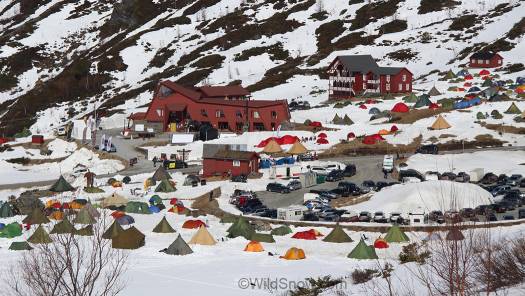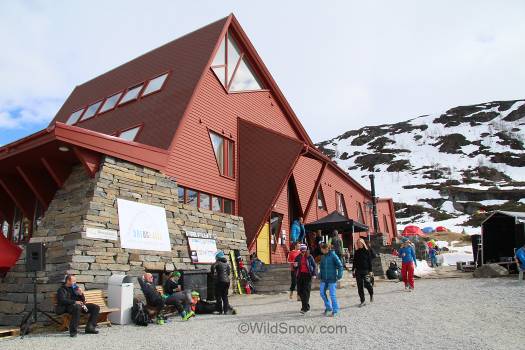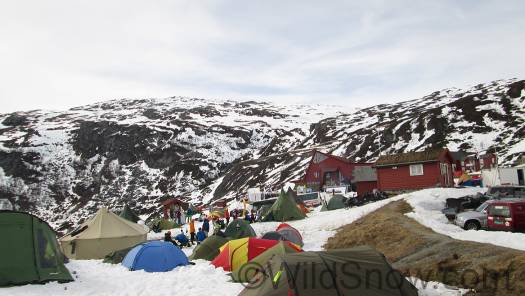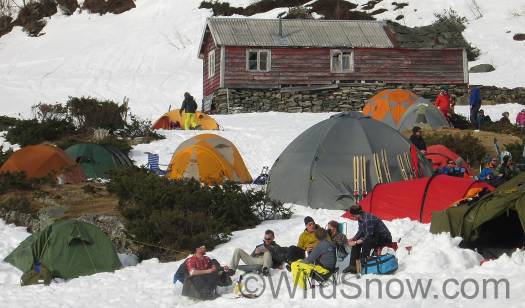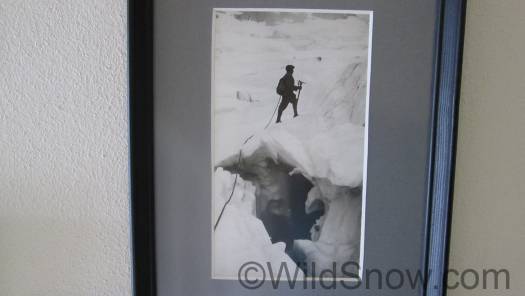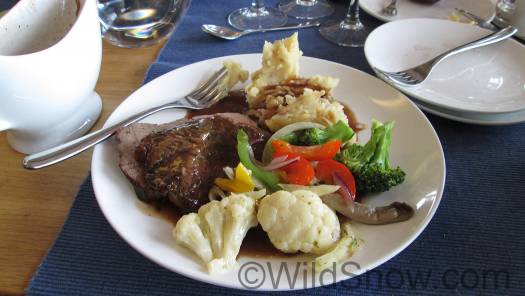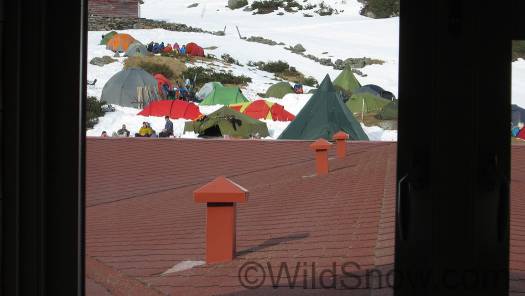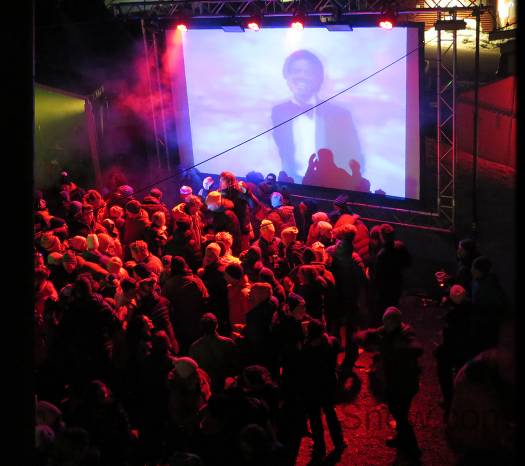
High Camp Turtagro, party night. Norway has odd customs, such as large groups of backcountry skiers dancing to a Michael Jackson video at 3:00 am, outside, in their puffy coats.
While a longer stay at Phillpshaugen is seductive — and we’re invited, Erlend Sande of Fri Flyt magazine for ski touring. has gone the extra kilometer keeping us moving through Norway. His end goal: for WildSnow.com to witness a unique event known as High Camp at roadside hotel and camp area known at Turtagrø. So we say a reluctant adios to the Oksendal Valley and do a seven hour scenic extravaganza drive to the new venue with our SLR hanging out the window the whole way like a low budget google-cam (oh, the photo editing to follow!)
We’ve done somewhat of a roundabout here, as we’re now back on the western side of the Jotunheimen (see beginnings of my Norway ski touring trip reports and maps below) in a region the guidebook calls the Hurrungane, or what I get the impression is also called the Sognefjellet mountains. This is another area of Norway where elevations climb high enough to make spring skiing reliable, with your start points and endings most often above timberline thus avoiding bushwhacks and dirt walks.
In previous posts, you’ve heard about the propensity of Norwegians to tent camp no matter what snow or weather might discourage those of us with lesser nerve. High Camp is the ultimate expression of this. Once a year, more than 500 campers (and a few hundred hotel goers as well) descend on Norway’s historic Turtagro Hotel (see map below) creating a tent city that resembles a thriving peasant market surrounding a feudal castle, only everyone here is dressed in the latest technical clothing and sporting shiny new ski touring kits. Days are spent skiing, with an all-night dance party closing things out.
“High Camp is our way of doing a ski resort scene without ski lifts” said Fri Flyt magazine’s Erland Sande, “it’s an expression of everything Norwegian about skiing…the touring, the fun as a group, the apre’ ski… High Camp is put on by the hotel and our magazine. It’s been going for 15 years… The Turtagro event is limited to 600 tickets but we have a camp at Lyngen as well, and others are being created.”
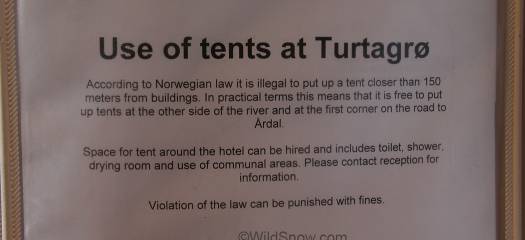
Tenting regulations,you are free to camp just about anywhere in Norway, public or private land, but you have to keep your distance from dwellings and such.
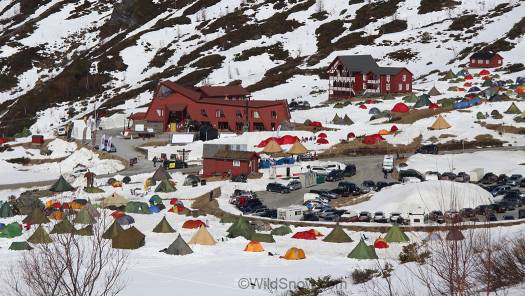
We couldn’t resist taking lots of photos. Who knows? Perhaps Colorado will have a festival like this someday.
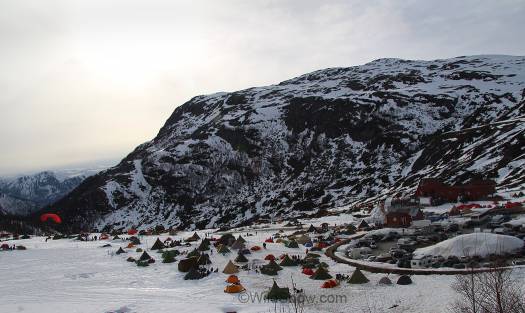
South facing terrain at this altitude had begun a melt-off, but everything else is covered in white.
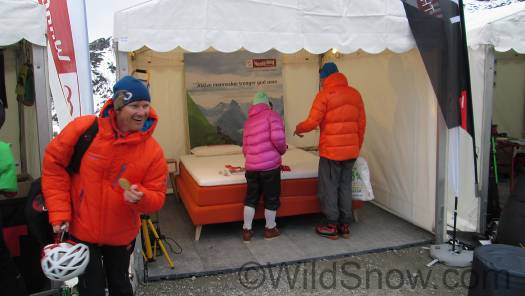
High Camp includes a mini gear expo. I got a laugh out of this mattress booth, one of only a half dozen companies present. In a region where it’s night nearly all “day” for several months, perhaps mattresses have a more serious connotation than I’m used to?
Let me emphasize that the Norwegian style of enjoying outdoor activities is one of complete comfort in less than ideal conditions. A good example: up here at Turtagro they’ve got a stone slab picnic table out in front. Several times I observed complete families plop down their whole cooking rig and whip up a complete meal, dressed in parkas with their hoods up, as clouds scudded overhead and snow fell. Sure, you see this elsewhere to some degree — and we’ve all done such things at times — but these picnickers appeared beyond comfortable, as if they were sitting in their kitchen by a hot stove having a coffee or tea.
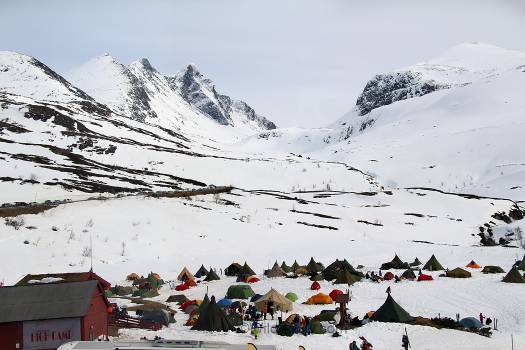
Turn and look away from the hotel. This is just a small slide of the pie. Skagastølstind peak to left is where alpine climbing began in Norway.
Turtagro has an interesting history involving both backcountry skiing and climbing. A jagged peak rising to the south, Store Skagastølstind, was first climbed in 1876 by pioneer alpinist William Cecil Slingsby. Coming from England, Slingsby fell in love with Norway and is widely considered to be the “father of Norwegian mountain climbing.” More, his ski traverse of Keiser Pass Pass in 1880 was foundational to ski mountaineering in Norway.
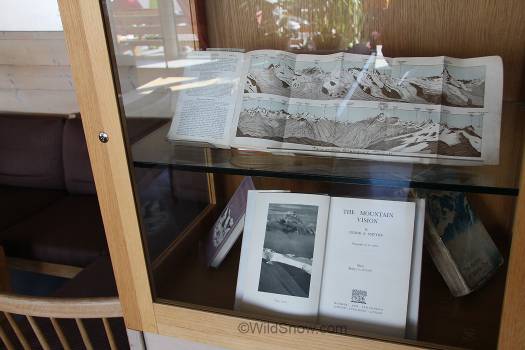
Turtagro honors the pioneers with a full library including historical as well as modern texts along with displays of early memorabilia, some from Slingsby. I always wonder at the future of paper-ink libraries, but there’s no denying how pleasingly tactile it is to page through classic alpine literature in a cozy mountain lodge. Makes me want to start smoking a pipe and wearing an alpi’ hat.

Much of the library is indexed. You’ll find just about every guidebook ever written for the area, including some in English, as well as collections of old club journals and publications, also some in English.
The original hotel was built in 1888, and burnt down in 2001. The new modern looking hotel pictured here began operations in 2002. While locals told us the original century-old hotel was an irreplaceable classic, we found the modern version to be quite attractive, with a friendly athletic spirit that honored its roots.
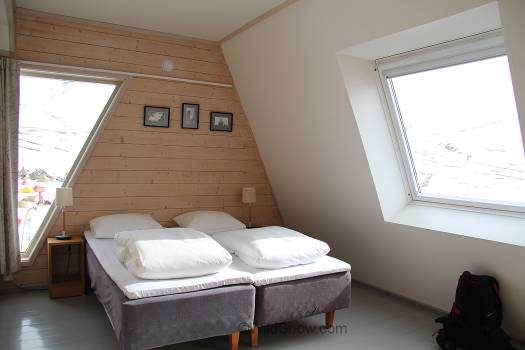
I’m not sure how Erlend swung us an upstairs corner room with amazing views. We were definitely humbled by being so taken care of. Or, we realized later that perhaps the Fri Flyt folks had another agenda entirely. Knowing we were probably not going to join the millennials at their all-night rage, our room was strategically located so the sound system literally vibrated our wall and bed like we were floating in an unimaginably powerful jacuzzi spa. More, one of the windows overlooked the event so Lisa caught a bunch of art shots with her SLR (as sleeping was somewhat out of the question).

Just a staircase, but shows how the hotel interior is design themed with clear wood finishes and white walls.
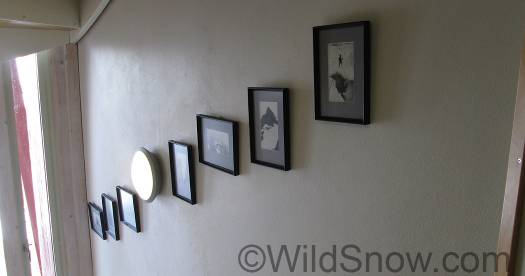
As with other lodges we’ve visited, Turtagro is big on local history. Dozens of wonderful photographs adorn.
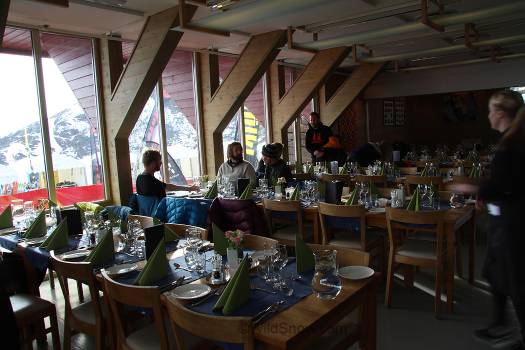
Hotel dining room seats about 70 people, two seatings when hotel is full. We were impressed by the quality of the food even with a full house and event happening.
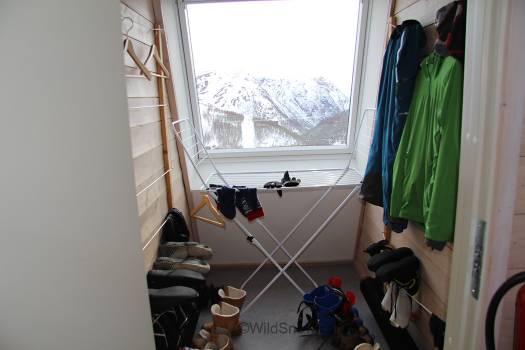
A clothing and boot drying room is located at the end of the room hall. We’re used to huts that require removal of ski boots before entering the living spaces. Turtagro doesn’t seem to have much concern with that but perhaps the rules for footwear got lost in the High Camp crowds.
Erlend and his crew at Fri Flyt published an excellent overview guidebook a while back, in Norwegian. They recently published an English edition that with my limited experience of Norway appeared wonderfully useful. Expensive, but if you plan a Norway ski touring trip I think this would be money well spent, especially if you’re self guiding. They sell a number of other guidebooks as well, some in English.
During spring snow seasons this place is about location, location, location. Key here is Sognefjellsvegen Mountain Road (#55, see video above), which climbs quickly out of sea-level regions to the hotel at 950 meters elevation, then up and over a vast area of higher ground. Literally thousands of backcountry ski touring options begin from the hotel and road. From what we could tell the ski touring season lasts quite nicely, with a spring touring sweet spot from perhaps late March to the middle of May. I’m guessing for planning a ski trip here you’d want to consider a block of days around the end of April on into early May. You can reach the hotel by bus, but be sure to arrange transportation to various trailheads if you’re self guided (ask the hotel about rides).
(Also, unless you want to experience massive group ski touring and party culture, avoid High Camp. But what would be the fun in avoidance? Perhaps attend High Camp but know that tickets are limited; do your homework on this during trip planning well in advance as the hotel will be totally booked during the three days of High Camp.)
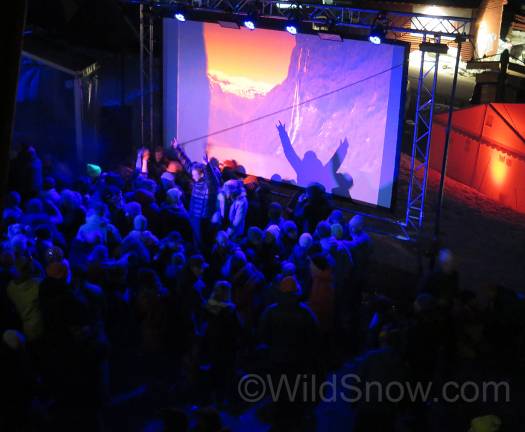
This guy was obviously getting his Viking on. They kept breakfast running a bit later the next morning, but I was amazed at how despite the all-night party, quite a few were toting overloaded breakfast plates and making sandwiches at 8:00 am, already wearing their ski boots. Yes, we know all Norwegians are born with skis on, but it’s new to me that they eat all their meals with their ski boots on. Learn something new every day.
WildSnow.com publisher emeritus and founder Lou (Louis Dawson) has a 50+ years career in climbing, backcountry skiing and ski mountaineering. He was the first person in history to ski down all 54 Colorado 14,000-foot peaks, has authored numerous books about about backcountry skiing, and has skied from the summit of Denali in Alaska, North America’s highest mountain.

